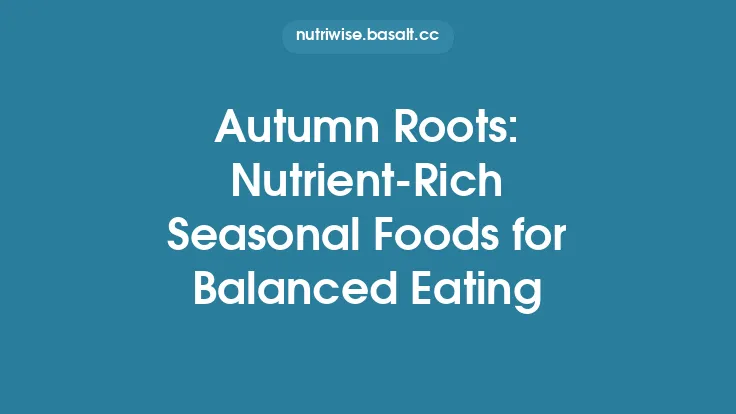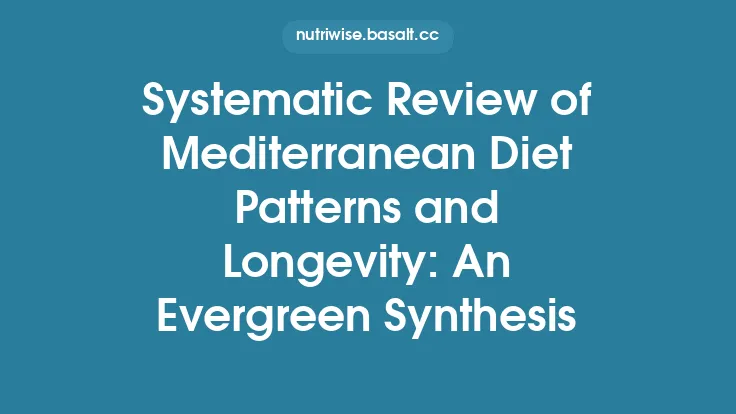The Nordic diet, rooted in the culinary traditions of Denmark, Finland, Iceland, Norway, and Sweden, is more than a collection of recipes; it is a holistic approach to eating that emphasizes locally sourced, seasonal, and minimally processed foods. Over the past few decades, researchers have highlighted how this dietary pattern supports longevity, reduces the risk of chronic disease, and promotes overall well‑being. By focusing on nutrient density, balanced macronutrients, and sustainable food systems, the Nordic diet offers a blueprint for health that can be adapted to modern lifestyles while preserving cultural heritage.
Foundations of the Nordic Dietary Pattern
The Nordic diet is built on five core principles:
- Local and Seasonal Produce – Prioritizing foods that grow in the region during their natural harvest periods, such as root vegetables in winter and berries in summer.
- Whole Grains Over Refined Grains – Emphasizing rye, oats, barley, and whole‑grain wheat, which retain bran, germ, and endosperm.
- Sustainable Protein Sources – Including fatty fish (e.g., herring, mackerel, salmon), lean game (reindeer, elk), and modest amounts of dairy from grass‑fed animals.
- Healthy Fats – Favoring rapeseed (canola) oil, which is high in monounsaturated fatty acids (MUFA) and omega‑3 polyunsaturated fatty acids (PUFA), over saturated fats.
- Minimal Processing – Choosing foods in their natural state, limiting added sugars, salt, and artificial additives.
These principles collectively create a diet that is rich in fiber, essential fatty acids, vitamins, minerals, and phytochemicals—components that have been linked to reduced inflammation, improved metabolic health, and enhanced cellular repair mechanisms.
Key Food Groups and Their Nutrient Contributions
Whole Grains
- Rye (Rugbrød) – A staple in Denmark, rye bread provides high levels of soluble fiber (β‑glucan), which can lower LDL cholesterol and improve glycemic control.
- Oats (Havregryn) – Oats are a source of avenanthramides, unique antioxidants that exhibit anti‑inflammatory properties. They also supply resistant starch, supporting gut microbiota diversity.
- Barley (Byg) – Rich in selenium and B‑vitamins, barley contributes to antioxidant defenses and energy metabolism.
Fatty Fish and Marine Products
- Herring, Mackerel, and Salmon – These cold‑water fish are abundant in long‑chain omega‑3 fatty acids EPA and DHA, which are critical for cardiovascular health, neuroprotection, and modulation of gene expression related to inflammation.
- Shellfish (e.g., mussels, shrimp) – Provide high‑quality protein, zinc, and iodine, supporting thyroid function and immune competence.
Berries and Wild Fruits
- Bilberries (Vaccinium myrtillus) – Contain anthocyanins that improve visual acuity and possess neuroprotective effects.
- Lingonberries (Vaccinium vitis‑idaea) – High in proanthocyanidins, which inhibit oxidative stress pathways.
- Cloudberries (Rubus chamaemorus) – Offer vitamin C, vitamin A (as β‑carotene), and essential fatty acids.
Root Vegetables and Brassicas
- Potatoes, Turnips, and Carrots – Provide complex carbohydrates, potassium, and beta‑carotene. The high potassium content helps regulate blood pressure.
- Cabbage, Kale, and Brussels Sprouts – Rich in glucosinolates, compounds that activate detoxifying enzymes (e.g., glutathione S‑transferases) and may reduce cancer risk.
Dairy and Fermented Products
- Skyr (Icelandic cultured milk) – A high‑protein, low‑fat dairy product that supplies calcium, vitamin D (when fortified), and probiotic cultures.
- Cultured Butter (Smör) and Fermented Cheeses – Contain conjugated linoleic acid (CLA), which has been associated with improved body composition and anti‑inflammatory effects.
Healthy Fats
- Rapeseed Oil (Rapsolja) – Offers a favorable omega‑6 to omega‑3 ratio (~2:1) and is a source of alpha‑linolenic acid (ALA), a plant‑based omega‑3 precursor.
- Nuts and Seeds (e.g., hazelnuts, flaxseeds) – Provide MUFA, PUFA, vitamin E, and phytosterols that support lipid metabolism.
Micronutrient Profile and Longevity‑Related Mechanisms
| Nutrient | Primary Nordic Sources | Role in Longevity |
|---|---|---|
| Vitamin D | Fatty fish, fortified dairy, sunlight exposure | Regulates calcium homeostasis, modulates immune response, reduces risk of osteoporosis and certain cancers |
| Omega‑3 (EPA/DHA) | Herring, mackerel, salmon | Anti‑inflammatory, improves endothelial function, supports brain health |
| Vitamin C | Berries, cloudberries, kale | Antioxidant, collagen synthesis, immune support |
| Selenium | Barley, whole‑grain rye, fish | Antioxidant enzyme (glutathione peroxidase) cofactor, thyroid hormone metabolism |
| Magnesium | Whole grains, nuts, leafy greens | Enzyme cofactor for DNA repair, glucose regulation |
| Potassium | Root vegetables, berries | Blood pressure regulation, counteracts sodium effects |
| Fiber (soluble & insoluble) | Whole grains, legumes, berries | Improves gut microbiota, lowers cholesterol, stabilizes blood glucose |
Research indicates that the synergistic action of these nutrients—often referred to as “food synergy”—enhances cellular resilience, reduces oxidative damage, and supports telomere maintenance, all of which are hallmarks of healthy aging.
Seasonal Eating and Its Impact on Nutrient Density
The Nordic climate imposes a distinct seasonal rhythm, compelling residents to align their diets with the natural harvest calendar:
- Winter (November–February): Emphasis on stored root vegetables, fermented foods (e.g., sauerkraut, pickled herring), and preserved berries. Fermentation increases bioavailability of B‑vitamins and introduces beneficial lactic acid bacteria.
- Spring (March–May): Fresh greens (e.g., sorrel, wild lettuce) and early‑season herbs appear, providing a surge of vitamin K and folate.
- Summer (June–August): Peak berry harvest (bilberries, lingonberries, cloudberries) and abundant fresh fish. Sunlight exposure also boosts endogenous vitamin D synthesis.
- Autumn (September–October): Harvest of whole grains, mushrooms, and tubers, delivering complex carbohydrates and vitamin D from wild mushrooms.
Seasonal eating not only maximizes nutrient content—since foods harvested at peak ripeness contain higher concentrations of phytochemicals—but also reduces reliance on imported produce, thereby lowering the carbon footprint of the diet.
Traditional Preparation Techniques that Preserve Nutrients
- Cold Smoking: Used for herring and salmon, this method retains omega‑3 fatty acids while adding phenolic compounds from the smoke that have mild antioxidant activity.
- Pickling and Fermentation: Cabbage (sauerkraut) and cucumbers are fermented with salt and native lactic acid bacteria, enhancing vitamin K2 production and probiotic content.
- Baking on Stone (e.g., rye flatbreads): Provides a dry‑heat environment that preserves the fiber matrix of whole grains and minimizes nutrient loss.
- Stewing (e.g., “lapskaus” – a hearty meat and root vegetable stew): Slow cooking at low temperatures helps retain water‑soluble vitamins and creates a nutrient‑rich broth.
These methods reflect a cultural emphasis on preserving food for the long, dark winters while maintaining nutritional integrity.
Health Outcomes Associated with the Nordic Diet
Cardiovascular Health
Large cohort studies from Sweden and Finland have demonstrated a 15–20 % reduction in cardiovascular mortality among individuals adhering to a high‑Nordic‑diet score. The combined effects of omega‑3 fatty acids, soluble fiber, and low saturated fat intake contribute to lower blood pressure, reduced triglycerides, and improved endothelial function.
Metabolic Regulation
The high fiber content (≈30 g/day) slows glucose absorption, leading to lower postprandial glucose spikes and improved insulin sensitivity. Additionally, the moderate protein load from fish and lean game supports lean muscle mass without excessive caloric surplus.
Cognitive Preservation
Omega‑3 fatty acids, particularly DHA, are integral components of neuronal membranes. Longitudinal data suggest that older adults consuming a Nordic diet have a slower rate of cognitive decline and a lower incidence of dementia compared with those following a Western diet.
Gut Microbiome Diversity
Whole grains, berries, and fermented foods provide prebiotic fibers and live cultures that foster a diverse microbiota. A balanced gut ecosystem is linked to reduced systemic inflammation, better mood regulation, and enhanced immune function—all factors that influence longevity.
Practical Guidance for Incorporating Nordic Principles
- Swap Refined Grains for Whole Grains – Replace white bread with rye or whole‑grain crispbread. Use oat porridge for breakfast.
- Prioritize Fatty Fish Twice Weekly – Aim for 100–150 g servings of herring, mackerel, or salmon. If fresh fish is unavailable, consider canned options packed in water or rapeseed oil.
- Add a Daily Berry Portion – Fresh, frozen, or dried (unsweetened) berries can be incorporated into smoothies, yogurts, or salads.
- Embrace Fermented Foods – Include sauerkraut, kefir, or skyr as side dishes or snack options.
- Use Rapeseed Oil for Cooking – Substitute butter or other vegetable oils with rapeseed oil for sautéing, baking, and dressings.
- Season with Herbs and Spices – Dill, juniper berries, and caraway seeds add flavor without excess sodium.
- Plan Seasonal Menus – Base meals on what is locally in season, reducing reliance on imported produce and ensuring peak nutrient density.
Sustainability and Cultural Preservation
Beyond health, the Nordic diet aligns with environmental stewardship. By focusing on locally sourced foods, it reduces transportation emissions. The emphasis on plant‑forward meals and modest animal protein portions lessens pressure on marine ecosystems. Moreover, preserving traditional recipes and cooking methods sustains cultural identity and intergenerational knowledge transfer.
Concluding Perspective
The Nordic diet exemplifies how a region’s climate, geography, and cultural practices can converge to create a dietary pattern that supports both longevity and ecological balance. Its foundation on whole, nutrient‑dense foods—particularly whole grains, fatty fish, berries, and fermented products—delivers a spectrum of vitamins, minerals, healthy fats, and bioactive compounds that collectively mitigate chronic disease risk and promote healthy aging. By adopting the core principles of seasonality, local sourcing, and minimal processing, individuals worldwide can harness the longevity‑enhancing benefits of this time‑tested Nordic culinary tradition.





